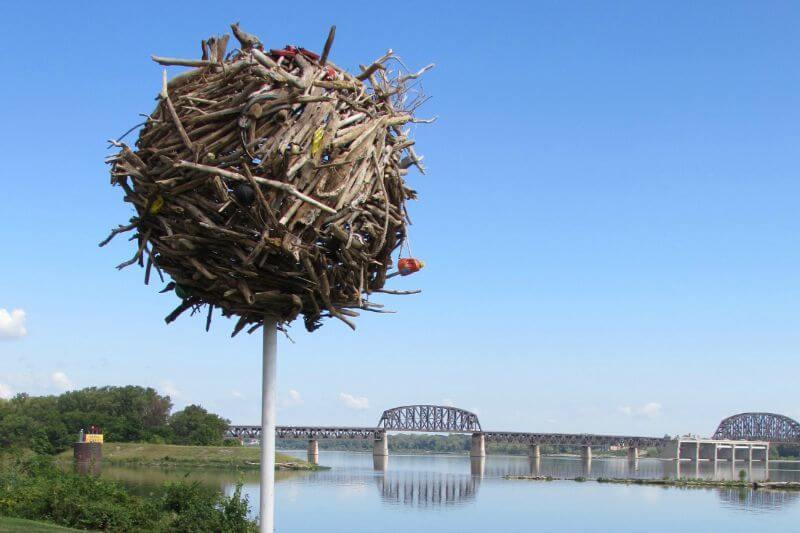Art represents the soul of a city. Louisville, and particularly Mayor Greg Fischer, know this is also a great way to invest in its people and neighborhoods. The mayor has been working to transform the space along the riverfront—as well as bring attention to the public art scene in Louisville—since he was elected in 2010. He’s made it a priority, really, and it’s been a tremendous success. Just look at the Big Four Pedestrian Bridge as an example of how these initiatives are being accepted by the community with open arms.
Along the Louisville Loop, between Eighth and 12th streets downtown, he recently unveiled Louisville’s inaugural public art exhibition: Connect|Disconnect. Located on the west side of Waterfront Park, this exhibition, on display through November, aims to activate the underutilized urban area along the Ohio River. Each installation is inspired by the uniqueness of Louisville and represents our past, present and future, shedding light on the rich history of our River City.
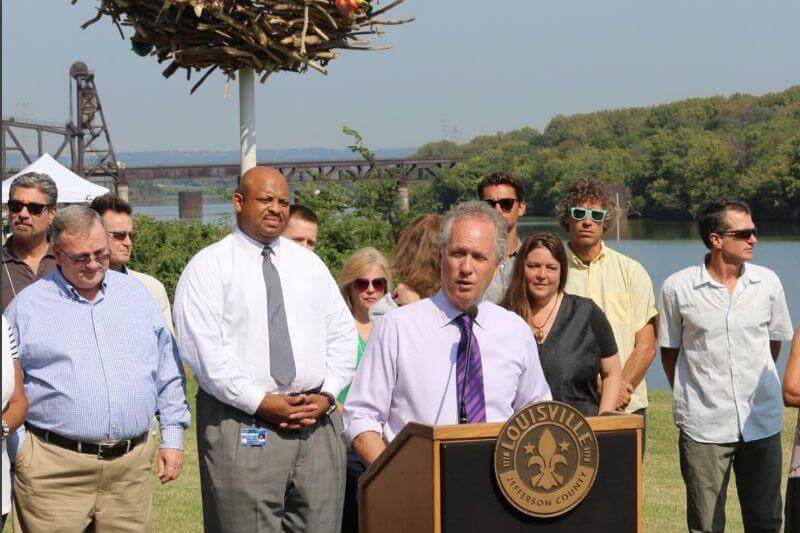
What’s in a name?
Connect people with their community, its history, the river and art in public spaces.
Disconnect from daily life through an art experience that is up-cycling the underused site.
The process of selecting artists began in early 2015. Twenty-one artists responded to a call for qualifications developed with Via Partnership, a commission management consultant. City leadership worked with the Commission of Public Art, Via Partnership and a curatorial panel to establish criteria with which to select the finalists: artistic excellence, goals, approach and capability. Artist submissions were organized and presented to city and project leaders to review, and a simple scoring process helped identify the five nationally recognized artists whose practices and approaches were most compatible with the scope of the project.
Let’s Take A Walk …
Anthropocene Fossils by Jean Shin
About the artist: Jean Shin is a Brooklyn-based artist whose work has been featured in more than 150 exhibitions internationally. Her installations reflect the personal lives of individuals, as well as the collective issues we, as a society, face. Learn more at jeanshin.com.
This installation is equally as beautiful as it is thought provokingly disturbing. Careful. If you blink, you’ll miss it. You might even step on it, if you’re not paying attention.
Jean drew inspiration for her project from the massive amounts of debris washed up along the riverfront and the nearby Falls of the Ohio. She cut cross sections into discarded plastic containers found in the river, exposing their interiors, then cast them into a concrete path.
“My project invites the public to contemplate the impact of consumer waste and post-industrialization on our environment,” she says.


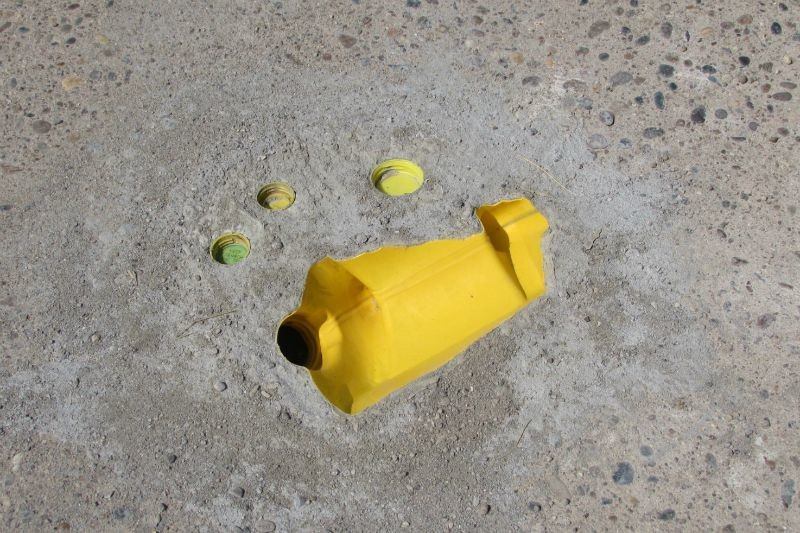
Upriver|Downriver by Mark Reigelman II
About the artist: Mark Reigelman II is also a Brooklyn-based artist who specializes in site-specific installations. His award-winning works have been featured in museums, galleries and public spaces from San Francisco and New York to Sidney and Shanghai. Learn more at markreigelman.com.
A faint bourbon aroma fills the air as the angel’s share escapes from the pyramid of barrels baking in the Kentucky summer heat. We love them for their bourbon, but barrels have played a more significant role in Louisville’s river city history than simply contributing to its bourbon culture.
“When I began research for this project, I was excited about the origins of Louisville. Stacks and stacks of barrels moved everything up and down this river,” Mark explains. “Their beautiful and simple form stacks in a very elegant way. ”
The sky-high stacks that once lined the riverfront are reimagined here to symbolize transportation, industry and growth. The artist attached a colorful, mirrored, acrylic surface to the 21 used barrels, each welded to the adjacent barrel, reflecting Louisville’s connection with the Ohio River.
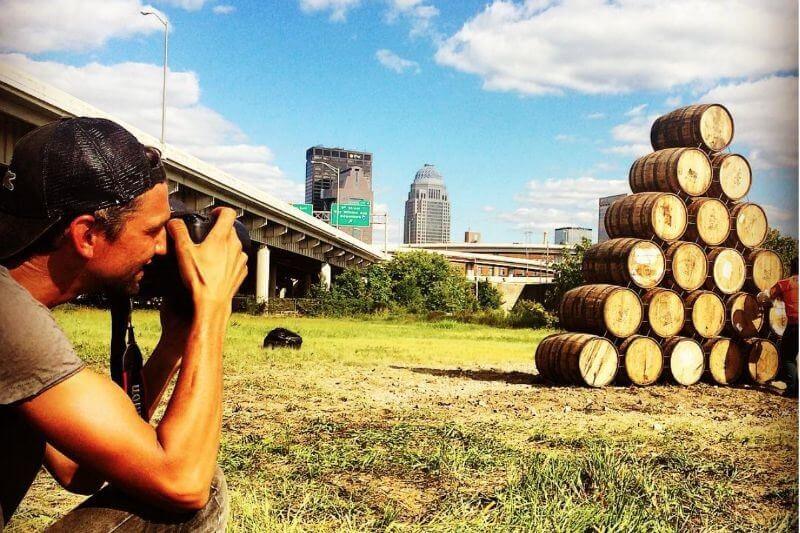
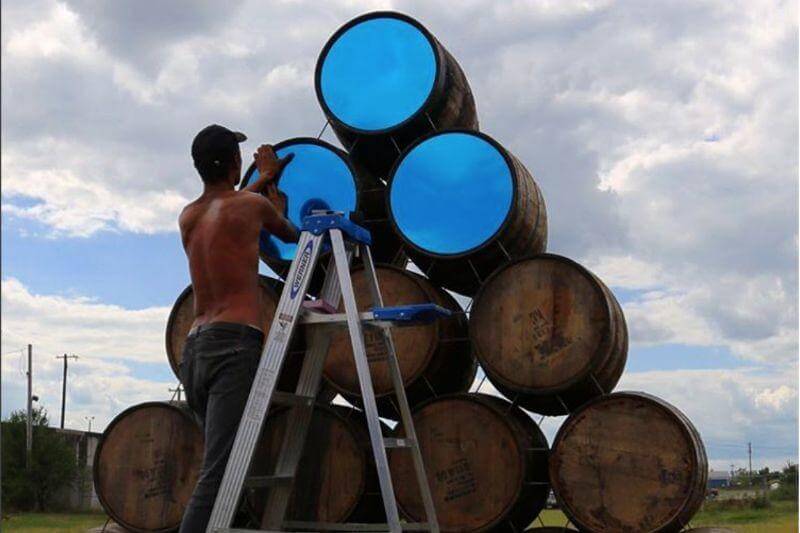

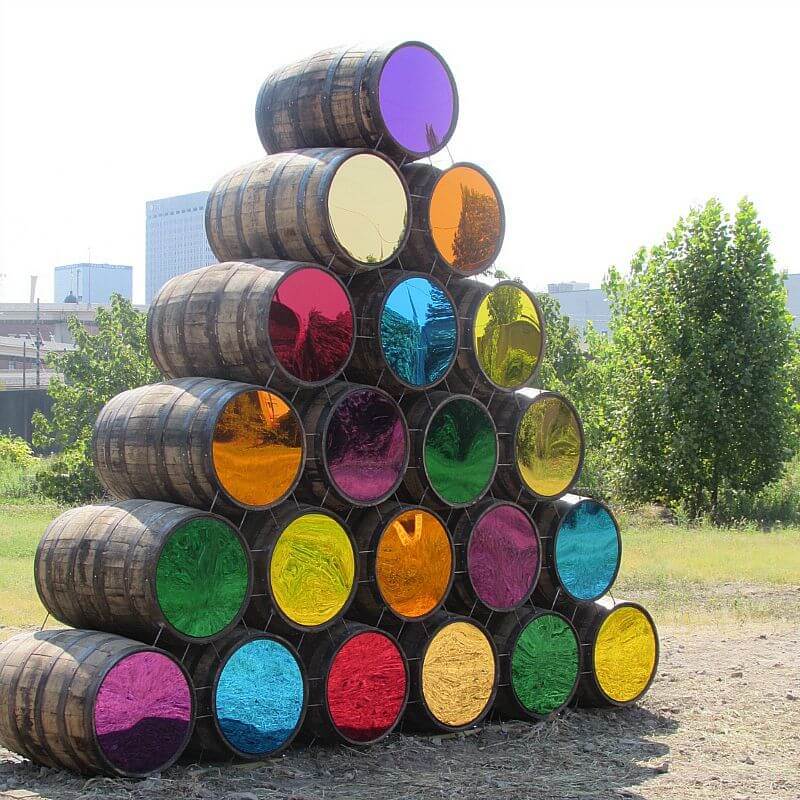
River Monument (glomus) by SIMPARCH
About the artists: Steve Badgett and Matt Lynch collaborate on site-specific installations under the name SIMPARCH, and often with art critics, builders and musicians. Their interactive work is approached with a DIY-type attitude, bringing together salvaged or recycled materials. Learn more at simparch.org.
This installation is probably the most intriguing at first glance. From a distance, it’s hard to discern what it is. The duo gathered thousands of pieces of driftwood from the river to create a cluster interlaced with debris to illustrate the unpredictability and power of the Ohio River.
“This stretch of the Ohio is not a quiet riverside, but an angry zone populated with a river of cars overhead and diesel rumblings from the barges,” the pair explains.
The wooded sphere intensifies this mechanical cacophony by producing a sound by composer Kevin Drumm that is often times in sync with or opposition to the site’s bellowing sonic overlays.
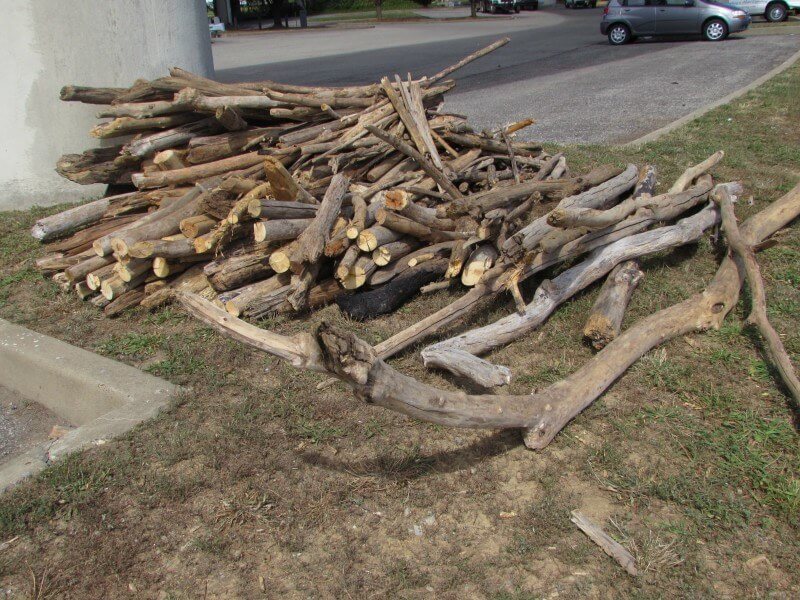
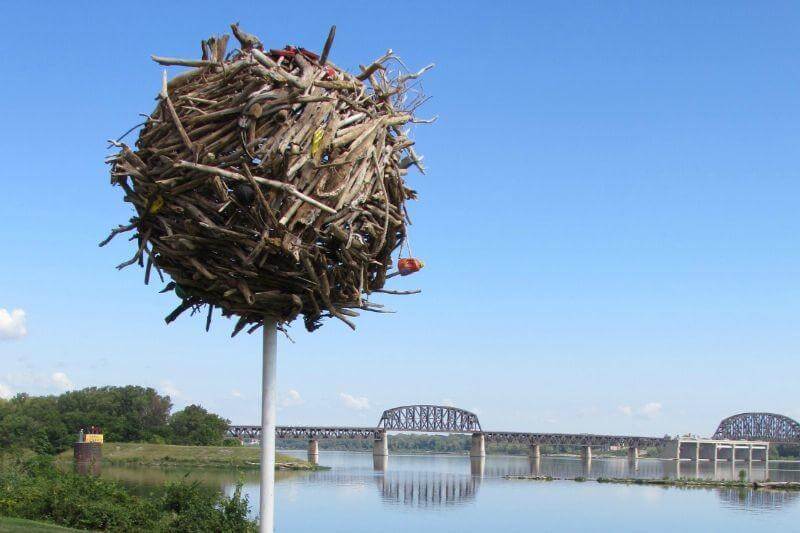
Beneath the Surface by Mary Carothers
About the artist: Mary Carothers is an associate professor of art at the University of Louisville. Her work revolves around both installations and public art to investigate issues of mobility, power and the collective, and individual, psychologies that influence American culture. Learn more at www.frozencar.com.
Nearly 2,400 porcelain-cast doorknobs affixed to iron rods of varying heights acknowledge the white clay of the Ohio River and entice you to take a closer look. Twenty-five designs each stand to represent an individual story, with the thousands coming together to form a mass representing this community’s history.
“The sculptural topography mimics the quality of river grass and aims to honor the many individual lives that have been overlooked or largely forgotten,” Mary says.
Examining the piece, you can find an L&N Railroad doorknob, one from a tobacco warehouse located on Main Street and one from a traveler’s gypsy wagon. The artist personally created the small hand that’s holding a banana to represent Louisville’s forgotten nickname “Little Panama;” the hair bun to honor Elmer Lucille Allen, the first African American to work as a chemist for Brown-Forman, and a lion from the door of St Mark’s Church in Belfast, Northern Ireland, in remembrance of Bloody Monday mob violence toward Irish Catholic immigrants in 1855.



Field of Vision: A Garden for Others by Jenny Kendler
About the artist: Jenny Kendler is an artist-in-residence for the Natural Resources Defense Council. Working at the intersection of art and science, her approach is to reconnect the relationship humans have with their natural world by blurring the line between nature and culture. Learn more at jennykendler.com.
Jenny noticed what seemed to be a butterfly highway along the Ohio River and pushed herself to make a work that, although is very complex, the public can appreciate on different levels. Inspired by the inner workings of a butterfly’s eye, she gathered native Kentucky plants, provided by local businesses, placing them in reclaimed hexagonal wooden planters, which provide an urban food source for the endangered Monarch butterfly. It also provides the very unique opportunity for humans to experience animal perception. The artist hacked solar-powered lights to emit ultraviolet light, giving evening viewers of her installation the experience of seeing in “butterfly vision.”

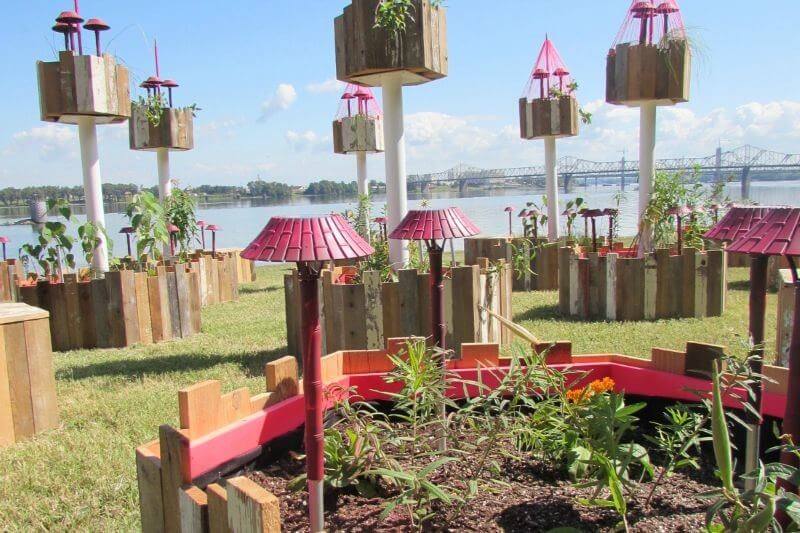
Experience this exhibition from anywhere:
Connect|Disconnect can be experienced anywhere in the world thanks to Mission Data, a local web design and development company. By downloading the free Otocast app, available for both iPhone and Android, you can hear from the artists in their own words.

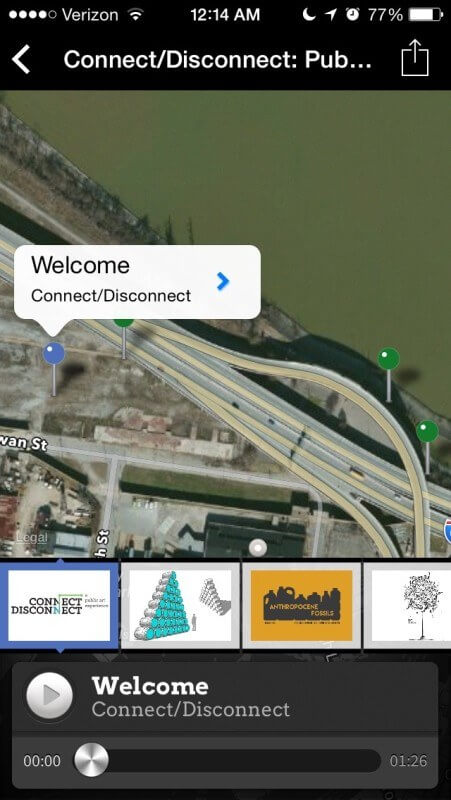
So what’s next?
The exhibition is located in a unique area of Louisville where transportation networks of all kinds dominate the view, and where the industrial past gives way to a repurposed future. Connect|Disconnect highlights the future site of Waterfront Park Phase IV as a temporary art walk.
Mike Kimmel, vice president of the Waterfront Development Corporation, says with the next phase of development, the public can expect a spray fountain, an extended overlook perched over the river and several iron trees symbolizing Louisville’s history as a leader in iron rod manufacturing.
“When you think of what we’ve done with Waterfront Park, we’ve transformed the area,” says Mayor Fischer. “As we move westward, it’s an exciting time to be in our city and in West Louisville.”
Periodic, live and interactive events are planned to complement the artworks and encourage visitors to experience the exhibit. The Kentucky Museum of Art and Craft is working together with Connect|Disconnect to offer family and curriculum guides, downloadable at kmacmuseum.com.
Connect|Disconnect, in collaboration with City Collaborative, will also play host to the popular ReSurfaced initiative for three days. The campaign, which works to breathe new life into the city’s underutilized urban spaces, is working to activate a 10th Street surface lot on the Louisville Loop October 15-17, for citizens to enjoy local food, beer and views of Downtown Louisville, the river and the public art exhibition.
Connect|Disconnect is free and open to the public through November 30.
**********



















